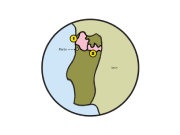

The rise of Portugal’s dry wine scene is one of the most exciting in the world right now. These reds are a big reason why.
As wine lovers, it is in our DNA to constantly look for and try new things. Whilst we definitely all have our ‘home comfort’ wines, arguably one of the most fascinating things about the world of wine is the pure range of juice available to quench our thirst for diversity. The rise of Portugal’s exciting wine scene has been well documented by wine buyers, tasters and journalists for quite a few years now. The reasons for this success are varied. Tales of ‘great value’ dominate, but what else has the wine geeks out there seen in Portugal? And why is it such a fascinating wine destination for anyone who is open to trying new things?

Touriga what?--red
In this guide, we will talk about the grapes. Portugal is a hotbed for local indigenous grape varieties, most of which are exclusive to the country or even the region in which they are grown. If you look hard enough, sure, you can find a bit of Syrah, Chardonnay or Cabernet Sauvignon here and there, but these are not the reasons one looks to Portugal. To cover all of the grapes under the Portuguese banner is a fool's errand, there are simply too many to talk about (almost 300). However, there are a few red varieties that are worth mentioning. Traditionally these hail from the Douro Valley wine region in the north, east of Oporto (Porto). These are also the core constituents of port wine; one of the vehicles for the success of the Anglo-Portuguese friendship over the centuries.
The following is just a snippet of the incredible range of grapes on offer in both Douro and wider Portugal. It is important to note that these grapes are usually co-planted in the same vineyard; they are picked together, fermented together and it’s not unheard of to have up to twenty different varieties from a given parcel of grapes, and in the final wine.
Blending--wines
Many of the world's 'blended' wines are composed post fermentation. Each variety is picked and vinified before they are blended together to create a product that is theoretically greater than the sum of its parts. This is where winemaker skill and a sharp palate come into play. In many cases the bottle will even state the proportion of the blend on the label, ‘60% Merlot’ and ‘40% Cabernet Franc’ for example. But this isn't always the case, and Portugal is well known for its ‘field blend’ wines. Many of these vineyards are old, really old, planted by farmers who relied on their agriculture to support the family who, at the time had little regard for the specific grape type that was taking root. There is no 30% of this and 10% of that at play here, for many of the wines in Portugal, the blend is made by the vineyard, not in the winery - very cool.
Here are five of the more prolific, popular grape types you will find not just in the Douro, but across the whole of Portugal.

Touriga Nacional--lavender
The jewel in the crown? Possibly. Nacional is widely considered to be the best red wine grape in Portugal. Think of it as their version of Sangiovese (Italy) or Tempranillo (Spain). Nacional is an aromatic red grape. It brings a wonderful elegance and perfume to a wine and it’s often responsible for those damson and violet aromas found in Port and table reds. Think of the process that you go through to taste wine; you look, you smell, and then you drink. Convert that into a 100m sprint, Touriga Nacional is that explosive first 10m of acceleration. Small berries, intense wines.
Touriga Franca--racy
The most popular red grape in the Douro in terms of area under vine, accounting for roughly 20% of plantings in the region. The perfect blending partner to the more aromatic and powerful Nacional. Franca offers structure and longevity. If Nacional is the bigger, more expressive grape, Franca reins it in slightly. Crucial for balance.
Touriga Barroca--strawberry
A high yielding grape, Barroca is a reliable variety that produces loads of fruit without losing quality - very important for harvest. Naturally high in sugar, this grape is important for maintaining alcohol levels in wine. Low in tannin and colour. The workhorse.
Tinta Roriz--burger
AKA Tempranillo!
OK, so not all of Portugal’s grapes are exclusively their own. It is little surprise that Spain’s number one variety has made the short journey across the border into Portugal. Crucial for colour, body and structure, Roriz is the antithesis of Tina Barocca. Also known as Arragonez in other parts of Portugal, namely in the south.
Tinta Cao--plum
Last but not least we have Tinta Cao. Instantly recognisable in the vineyard due to a small, secondary side bunch of grapes that protrudes alongside the main bunch. Cao offers spice and a lovely floral elegance to the final wine. This grape variety also performs well in cooler vintages, making it a reliable outlet in years where the weather isn't so good. Some winemakers have compared Tinta Cao to Syrah, as it can bring a bit of spice and pepper to a wine.
About the Author
Harry started his adventures in New Zealand learning how to make wine before squishing grapes with his feet (literally) in Portugal. He is a contributing wine writer for a number of UK magazines as well and a former wine director and consultant specialising in wine list development. When he isn’t drinking wine, he loves a beer and collecting records before spinning a few tunes.
Do you know your wine personality? If your answer is no, take our quiz to find out which wines to pick up next and build your box!
Build my box





